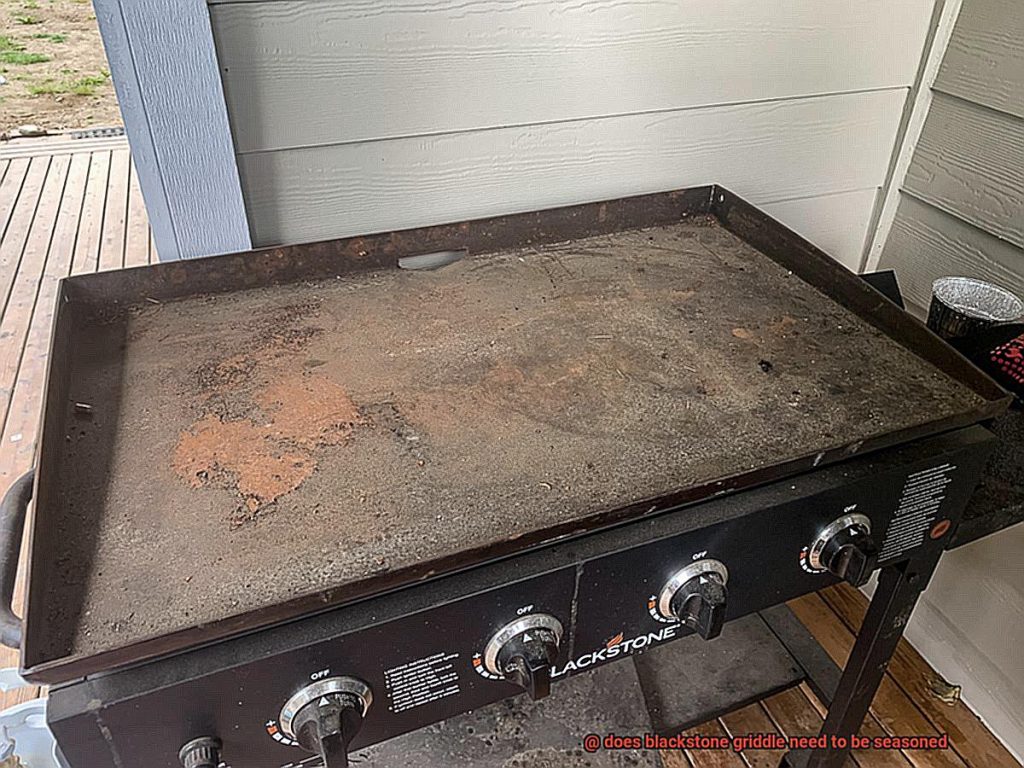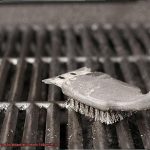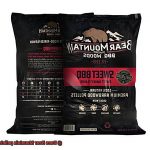Are you a grilling enthusiast who’s ready to take your cooking game to the next level with a Blackstone griddle? If so, you might be wondering if it needs to be seasoned like cast iron. The answer is a resounding yes. Seasoning your Blackstone griddle is an essential step that not only enhances the flavor of your food but also extends the life of your griddle.
But what exactly is seasoning? Essentially, it’s the process of creating a non-stick layer on the surface of your griddle by applying cooking oil and heating it. This layer protects against rust and prevents food from sticking to the surface. However, it’s important to note that seasoning isn’t a one-and-done deal. You’ll need to season your Blackstone griddle regularly to maintain its non-stick surface.
Now, you might be thinking: why bother with all this effort? Well, there are plenty of benefits to seasoning your Blackstone griddle. For starters, it makes cooking and cleanup much easier since food won’t stick as easily. Additionally, seasoned griddles are less likely to rust, which means they’ll last longer and provide better value for your money.
So now that you understand just how crucial seasoning is for your Blackstone griddle, stay tuned for our upcoming blog posts where we’ll walk you through the step-by-step process of seasoning like a pro. With our help, you’ll be able to enjoy perfectly cooked meals without any hassle or frustration.
Contents
The Benefits of Seasoning a Blackstone Griddle
As someone who is well-versed in all things Blackstone griddles, I can attest to the fact that seasoning your griddle is crucial for both home cooks and professional chefs alike. Not only does it enhance the non-stick properties of the cooking surface, but it also safeguards the metal from rust and corrosion, ensures even heat distribution, and can even elevate the flavor of your food.
Let’s take a closer look at these benefits. Firstly, seasoning a Blackstone griddle improves its non-stick properties significantly. This means that food will slide off effortlessly, making it easier to cook and clean up afterward. For those who enjoy cooking delicate foods like fish and vegetables, this is especially important since they tend to stick to surfaces.
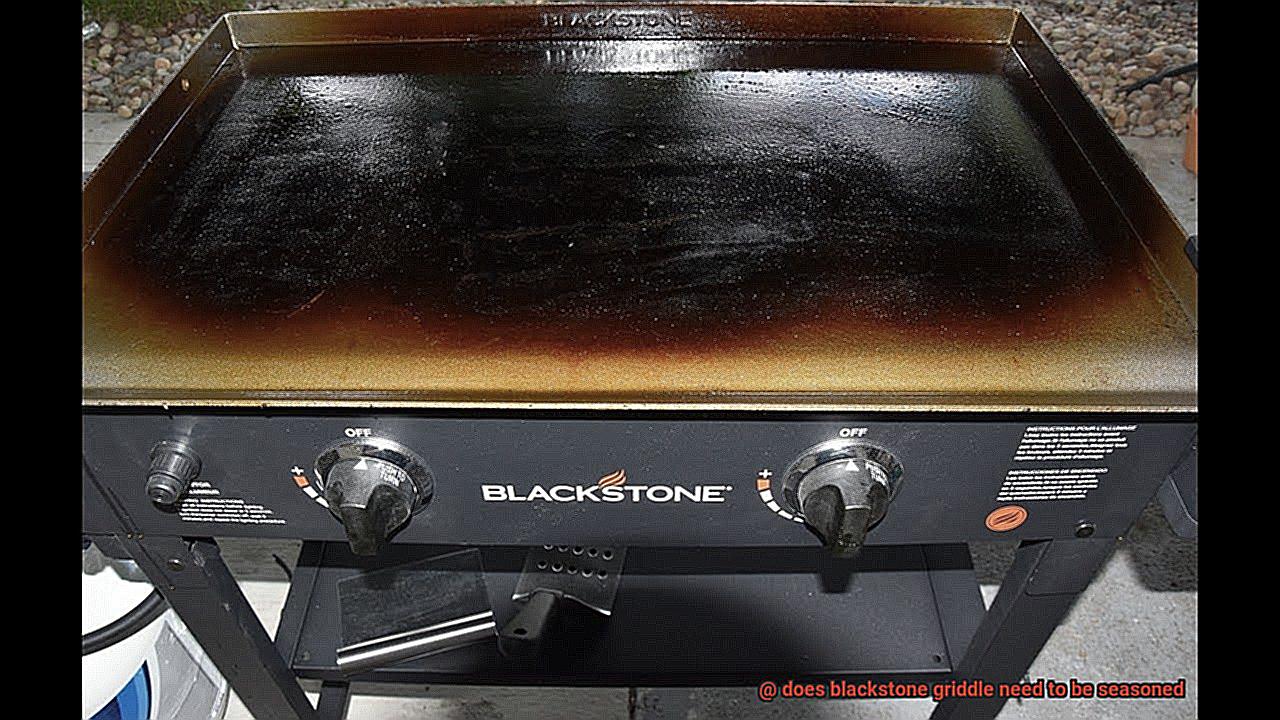
Moreover, seasoning protects the metal from rust and corrosion. Without proper seasoning, the metal can deteriorate over time, leading to rust spots and other signs of wear and tear. By seasoning your griddle regularly, you can prevent these issues and extend the lifespan of your cooking surface.
Another significant advantage of seasoning a Blackstone griddle is that it promotes even heat distribution across the cooking surface. When the metal is properly seasoned, it retains heat more effectively, allowing food to cook more evenly and reducing the risk of hot spots or uneven cooking. This is crucial for achieving perfectly cooked meals every time.
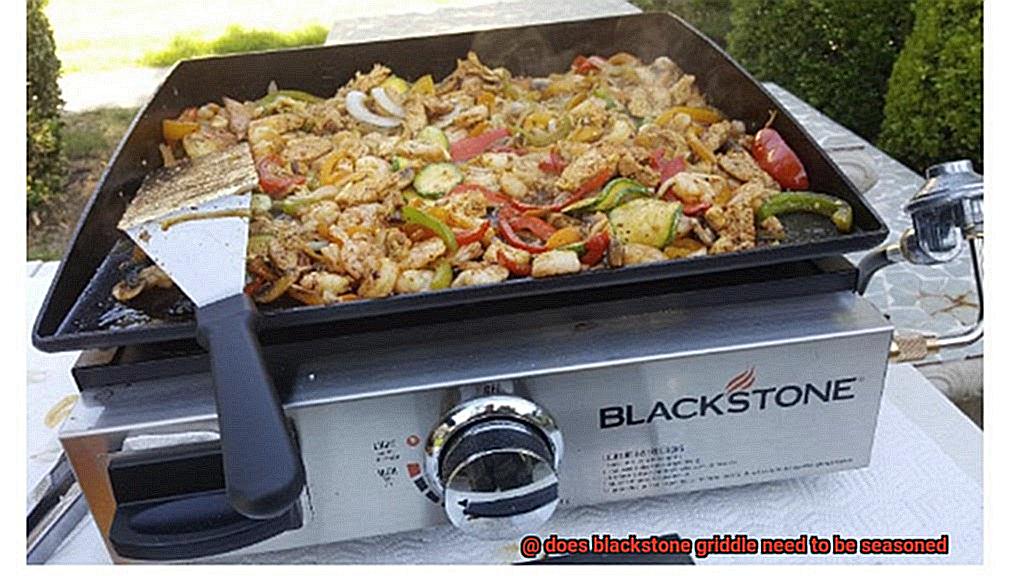
Finally, seasoning a Blackstone griddle can even improve the flavor of your food. As the oil penetrates the pores of the metal, it creates a natural non-stick coating that adds flavor to your food without adding extra fat or calories. This is particularly beneficial when cooking meats or other savory dishes.
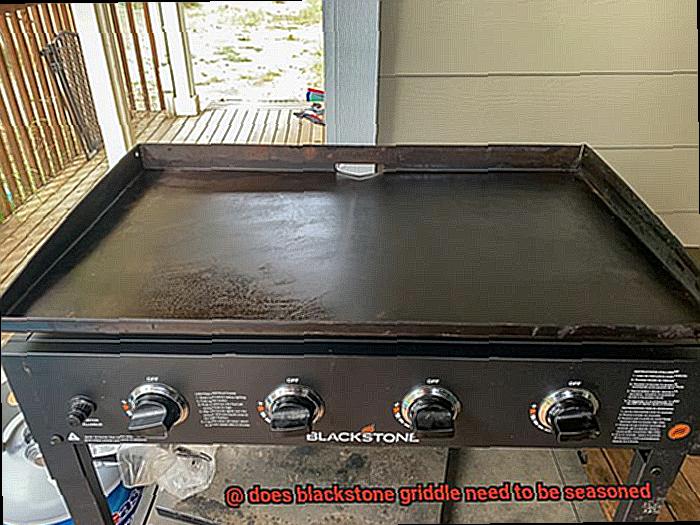
How to Season a Blackstone Griddle
Seasoning your Blackstone Griddle is a crucial step in ensuring that you can cook your meals perfectly and enjoyably. A well-seasoned griddle will have a non-stick surface, which makes cooking and cleaning up a breeze. In this guide, we’ll show you how to season your Blackstone Griddle in five simple steps.
Step 1: Clean the Griddle
Before seasoning your Blackstone Griddle, it’s essential to clean it thoroughly. Use a scraper or spatula to remove any debris or leftover food particles. Next, use hot water and soap to clean the surface of the griddle, making sure to rinse it thoroughly with water to remove any soap residue.
Step 2: Apply Oil
The best oil to use for seasoning a Blackstone Griddle is flaxseed oil. Flaxseed oil has a high smoking point, which means it can withstand high temperatures without burning or smoking. Pour a small amount onto the surface of the griddle and spread it evenly using a paper towel or cloth. Make sure to cover the entire surface of the griddle, including the edges and corners.
Step 3: Heat it Up
Turn on the heat and let the griddle warm up. The heat will help to bond the oil to the surface of the griddle, creating a non-stick coating. Let it heat up for at least 15 minutes or until you see smoke rising from the surface. This process helps to create a layer of hardened oil on the griddle surface that gives food an excellent taste.
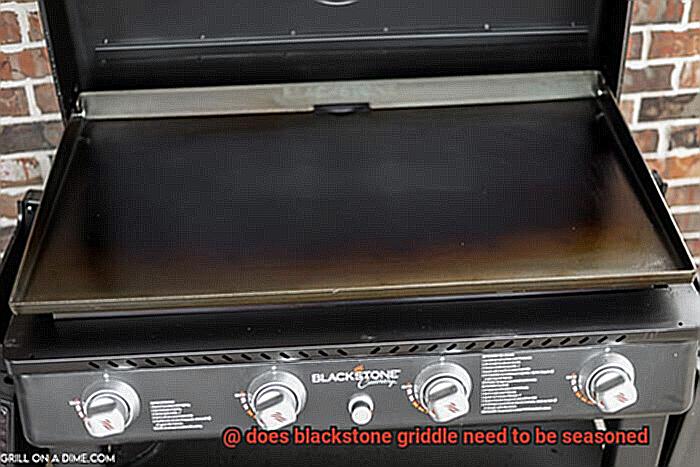
Step 4: Let it Cool
After 15 minutes of heating up, turn off the heat and let the griddle cool down completely. Once it’s cool, use a paper towel or cloth to wipe off any excess oil.
Step 5: Repeat
To build up a thick layer of seasoning on your Blackstone Griddle, repeat this process several times. You may need to repeat the seasoning process three or four times to achieve the desired non-stick surface. By doing this, you will have a well-seasoned griddle that will make cooking your favorite meals a joy.
It’s essential to note that seasoning is not a one-time event. You should season your Blackstone Griddle regularly, especially if you use it frequently. This will help maintain the non-stick coating and prevent rust from forming.
Common Mistakes When Seasoning a Blackstone Griddle
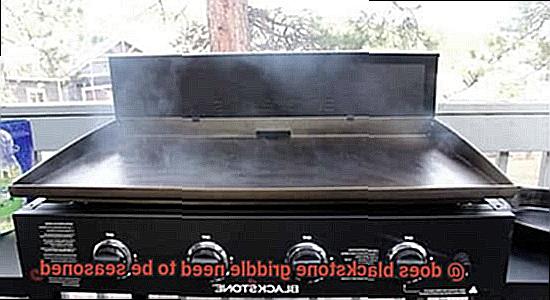
However, many people make common mistakes that can result in uneven seasoning and unpleasant flavors on your food. Here’s what you need to know to avoid these mistakes and season your Blackstone griddle like a pro.
Firstly, it’s essential to properly clean the griddle before seasoning it. Any debris or residue left on the surface can cause uneven seasoning and affect the taste of your food. So, take the time to clean the griddle thoroughly before beginning the seasoning process.
Another mistake people often make is using too much oil during the seasoning process. While oil is necessary to create a non-stick surface, using too much of it can lead to sticky and difficult-to-work-with seasoning. It’s recommended that you use a thin layer of oil while seasoning your griddle for best results.
Additionally, be sure to allow enough time for the seasoning process to take place. Depending on the specific type of Blackstone griddle you have, this could take anywhere from 30 minutes to an hour. Giving your griddle enough time to properly absorb the oil and develop a non-stick surface will ensure that you get the most out of your griddle every time you use it.
Lastly, using the wrong type of oil during the seasoning process can also be a mistake. To avoid any smoky or unpleasant taste on your food, use a high smoke point oil such as vegetable, canola, or flaxseed oil. Avoid oils with low smoke points like olive or butter.
Tips for Maintaining Your Blackstone Griddle After Seasoning
You invested in a Blackstone griddle, and you know how important it is to season it properly to ensure your meals cook evenly. But did you know that maintaining your griddle after seasoning is just as crucial? Here are five tips on how to maintain your Blackstone griddle after seasoning:
Clean regularly
Cleaning your griddle after each use is vital to prevent the buildup of grease and food particles. Use a scraper or spatula to remove any excess food, then wipe the surface with a damp cloth or paper towel. If there are stubborn stains, use a grill stone or cleaning brick to scrub them away.
Season as needed
Over time, the seasoning on your Blackstone griddle may wear off. If you notice food sticking to the surface or discoloration, it’s time to re-season it. Apply a thin layer of oil and heat until it starts to smoke.
Store properly
When not in use, store your Blackstone griddle in a dry area, away from moisture or humidity. You can cover it with a protective cover or tarp to keep dust and debris from accumulating on the surface.
Use the right tools
Avoid using metal utensils or abrasive cleaners on your griddle, as they can scratch the surface. Instead, use plastic or wooden utensils and non-abrasive cleaners safe for griddles.
Use high-heat oil
Cooking on your griddle with high-heat oil such as canola oil or vegetable oil prevents sticking and helps protect the surface.
Different Types of Oil Used for Seasoning a Blackstone Griddle
When it comes to seasoning a Blackstone griddle, choosing the right oil is essential for achieving the best results. The type of oil used can affect the griddle’s durability, non-stick properties, and even the flavor of your food. Here are five different types of oils that you can use for seasoning your Blackstone griddle.
Vegetable Oil
Vegetable oil is a popular and affordable choice for seasoning a Blackstone griddle. It has a high smoke point, which means that it can handle high temperatures without burning or smoking. This makes it perfect for searing and cooking at high heat. It is also readily available, making it a convenient option for many people.
Flaxseed Oil
If you’re looking for an oil that can create a durable and non-stick surface on your Blackstone griddle, then flaxseed oil is an excellent choice. Although it has a low smoke point, it is known for creating a long-lasting seasoning that will keep your griddle in top condition.
Canola Oil
Canola oil is another affordable option that works well for seasoning a Blackstone griddle. It has a neutral flavor and a high smoke point, making it ideal for high-heat cooking. Additionally, it is rich in monounsaturated fats, which are beneficial for heart health.
Coconut Oil
For those who prefer natural oils, coconut oil is an excellent choice for seasoning a Blackstone griddle. It has a sweet flavor and a high smoke point, making it suitable for high-temperature cooking. Additionally, it contains lauric acid, which has antimicrobial properties that can help to keep your griddle clean and hygienic.
Avocado Oil
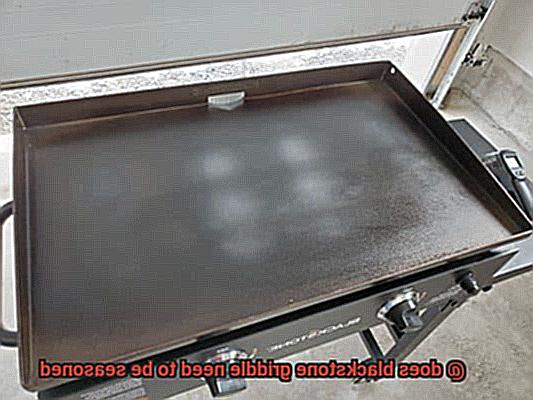
Avocado oil is another natural oil that works well for seasoning a Blackstone griddle. It has a mild flavor and a high smoke point, making it perfect for searing and stir-frying. Additionally, it is rich in monounsaturated fats, which are beneficial for heart health.
The Difference Between Pre-Seasoned and Unseasoned Griddles
The solution might be as simple as choosing the right type of griddle. Pre-seasoned and unseasoned griddles both have their own unique benefits, but there are some key differences between the two.
Firstly, pre-seasoned griddles are already equipped with a layer of seasoning on the cooking surface. This seasoning is typically made of vegetable or soybean oil that has been heated to a high temperature and allowed to cool. This results in a natural non-stick surface that not only prevents food from sticking but also adds extra flavor to your meals. However, it’s important to note that pre-seasoned griddles tend to be more expensive than unseasoned ones due to the extra preparation involved in their manufacturing.
On the other hand, unseasoned griddles require some effort before they can be used effectively. Before seasoning the cooking surface with a thin layer of oil, it’s crucial to remove any protective coating or rust inhibitor that might be present. Once this is done, heating up the griddle until the oil begins to smoke will create a polymerized layer that forms a natural non-stick coating on the griddle. While this process may seem daunting, it’s important to remember that an unseasoned griddle can potentially save you money in the long run.
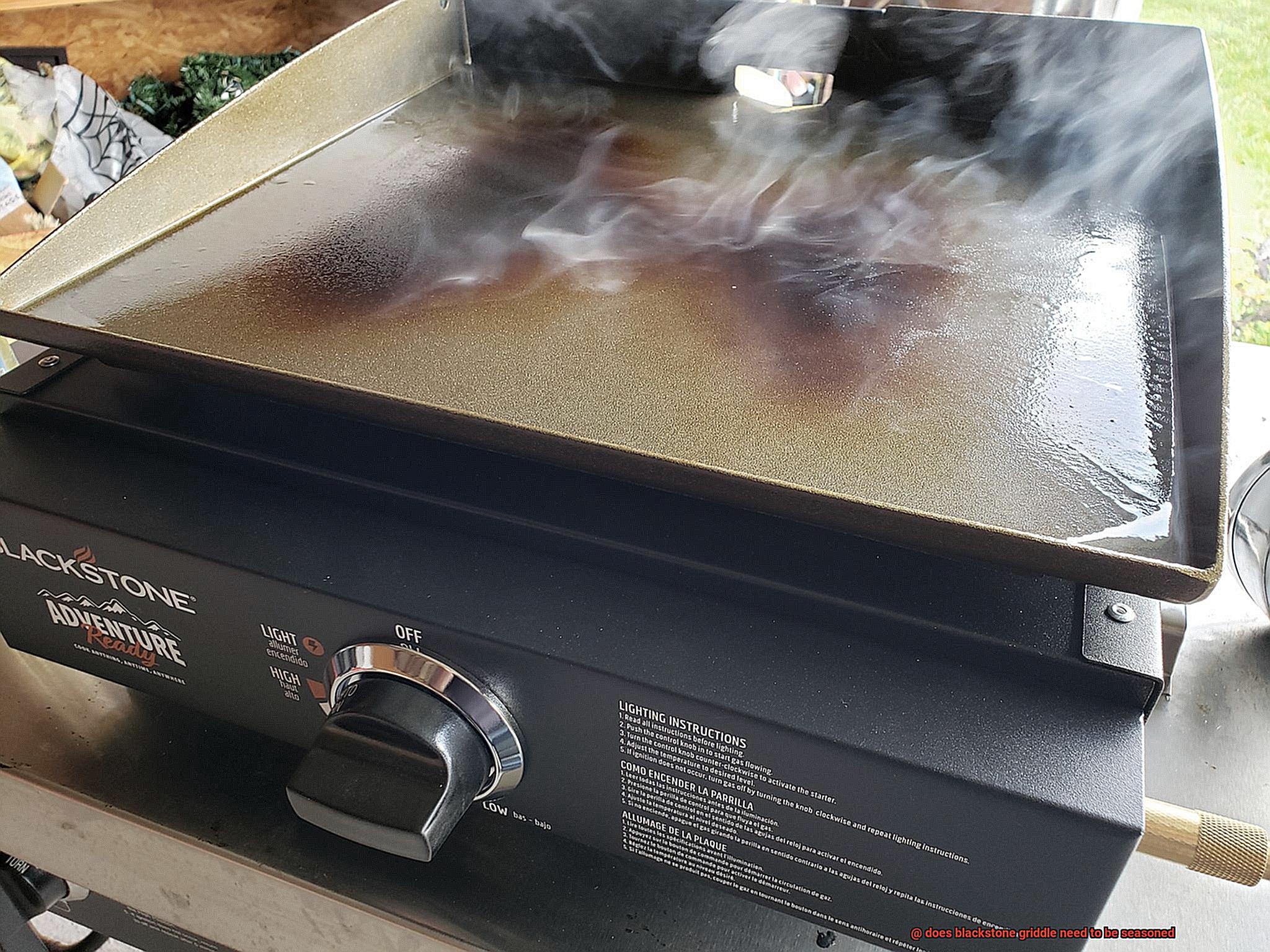
In summary, the main difference between pre-seasoned and unseasoned griddles is the amount of preparation required before use. Pre-seasoned griddles offer a hassle-free experience straight out of the box, while unseasoned griddles require some extra effort but can potentially save you money. Both types of griddles can provide excellent cooking results with proper care and maintenance.
How Often Should You Re-Season Your Blackstone Griddle?
One essential aspect of maintaining your griddle is re-seasoning. So, the question is, how often should you do it?
The answer is not set in stone and depends on various factors such as how frequently you use your griddle and how well you take care of it. According to our research notes, it’s generally recommended to re-season your Blackstone griddle after every 3-4 uses or when food starts to stick to the surface.
However, there are other factors that can affect the frequency of re-seasoning. If you’re cooking high-fat foods or using high temperatures, your griddle may need re-seasoning more frequently. Conversely, if you’re cooking lower-fat foods at lower temperatures, you may be able to go longer before re-seasoning.
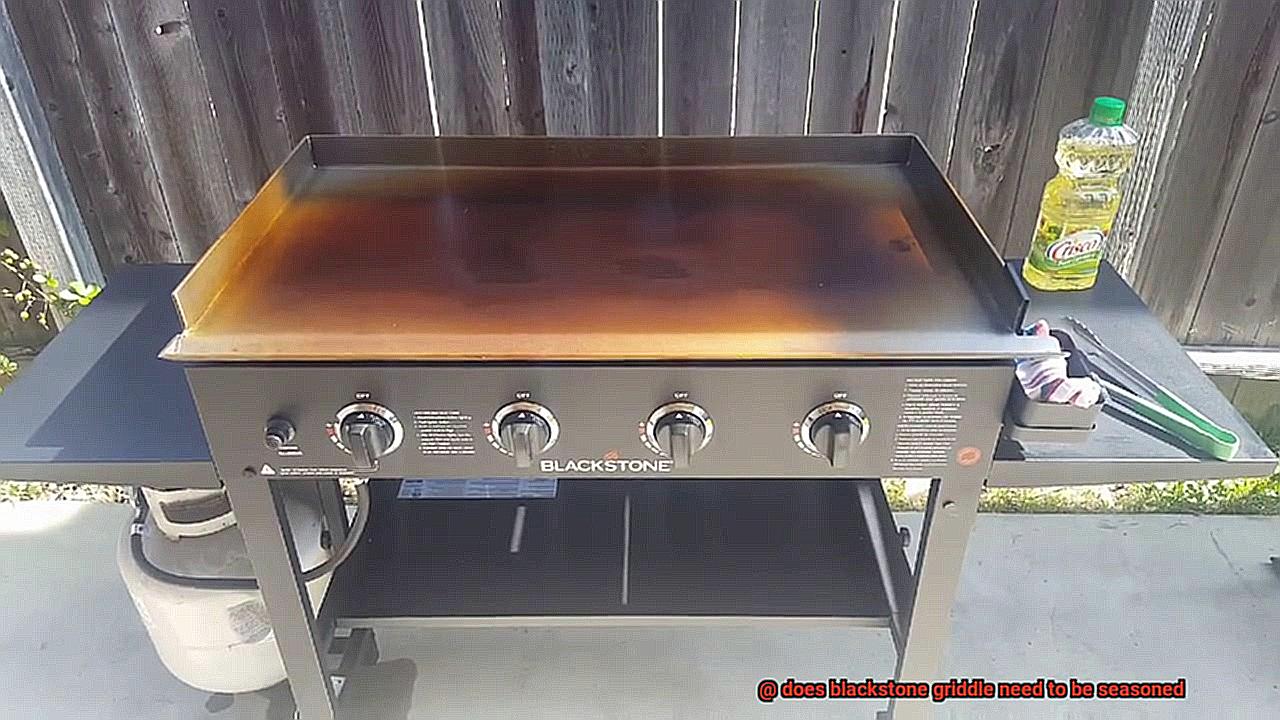
It’s important to note that proper cleaning and maintenance are crucial in extending the time between re-seasoning. After each use, make sure to clean your griddle with mild soap and water and avoid using any harsh chemicals or abrasive materials that can damage the seasoning.
Ultimately, the best way to determine when to re-season is by paying attention to how your griddle performs. If food is sticking or if the surface appears dull and worn, it’s a tell-tale sign that it’s time for a fresh coat of seasoning.
In summary, here are some key takeaways on how often you should re-season your Blackstone griddle:
- Re-season after every 3-4 uses or as needed
- Factors such as the type of food and cooking temperature can affect the frequency of re-seasoning
- Proper cleaning and maintenance can extend the time between re-seasoning
- Pay attention to how your griddle performs to determine when it needs a fresh coat of seasoning
Other Ways to Protect Your Blackstone Griddle from Rust and Wear
When it comes to outdoor cooking, a Blackstone griddle is a fantastic investment. However, without proper maintenance, rust and wear can quickly take their toll. While seasoning is an important step, there are other ways to ensure your griddle stays in top condition. Here are five methods to consider:
Protective Covers
One of the most effective ways to protect your griddle from the elements is by using a custom-fitted cover. Not only will it keep your griddle clean and ready for use, but it will also prevent rust from accumulating on the surface.
Regular Cleaning
Keeping your griddle clean after each use is crucial in preventing rust and wear. Use a mild soap and water solution to remove any debris from the surface, and make sure to dry it thoroughly afterward.
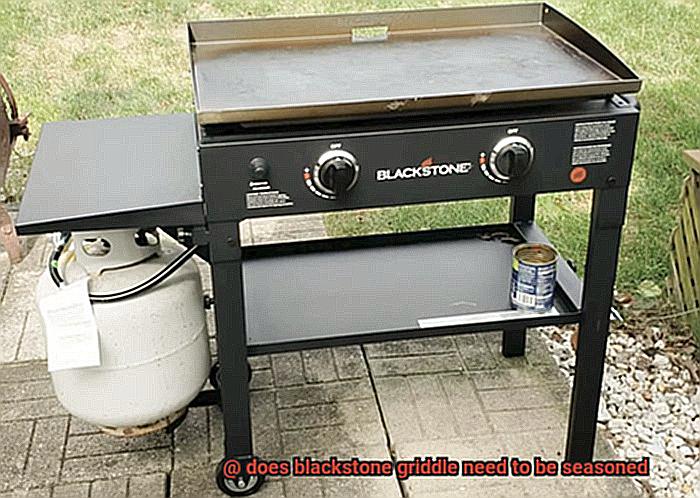
Apply a Coating
Applying a food-grade oil or spray can help create a barrier between the surface and contaminants, while also providing a non-stick cooking surface. This will not only protect your griddle but also improve your cooking experience.
Proper Storage
When storing your griddle during the off-season, make sure to clean and dry it thoroughly before placing it in a dry, cool place. This will prevent moisture from accumulating on the surface and causing rust or corrosion over time.
Use Baking Soda
If you notice any rust spots on your griddle, you can easily remove them with baking soda. Simply mix baking soda with water to form a paste and apply it to the rust spot. Let it sit for 30 minutes before scrubbing with a cloth or brush.
Conclusion
To sum it up, seasoning your Blackstone griddle is a must-do step that will take your cooking game to the next level. Not only does it add an extra layer of flavor to your food, but it also prolongs the lifespan of your griddle. Seasoning refers to the process of creating a non-stick surface on your griddle by heating cooking oil on its surface. This layer acts as a shield against rust and prevents food from sticking.
Keep in mind that seasoning isn’t a one-time event. Regular seasoning is essential for maintaining the non-stick surface of your Blackstone griddle. The advantages of seasoning are vast and varied. Firstly, it makes cooking and cleaning simpler since food won’t stick as easily. Additionally, seasoned griddles are less likely to rust, which means they’ll last longer and provide better value for money. Moreover, seasoning promotes even heat distribution across the cooking surface and can even enhance the flavor of your dishes.
To season your Blackstone Griddle properly, you should start by thoroughly cleaning it before applying a thin layer of oil and heating it until smoke appears. Repeat this process several times to build up a thick layer of seasoning on your griddle.
Lastly, proper maintenance is just as crucial as proper seasoning itself. Cleaning regularly, storing properly, using high-heat oil for cooking, and re-seasoning when necessary are all important factors in keeping your griddle in top condition.

